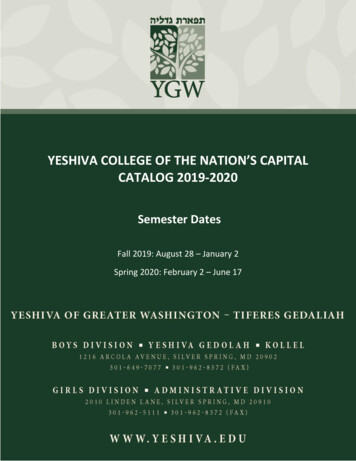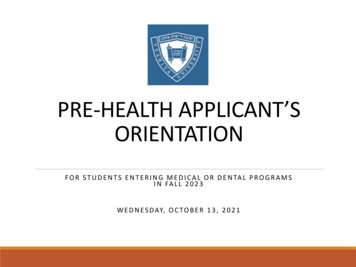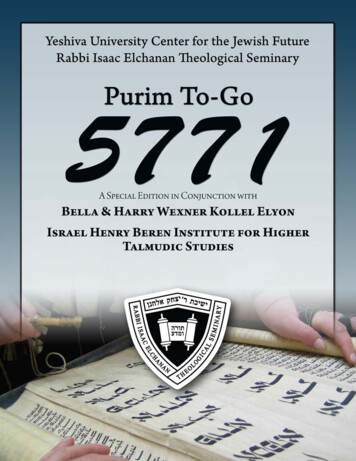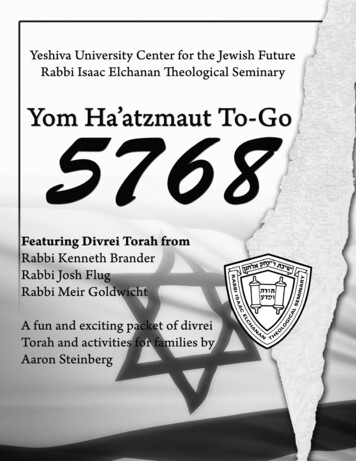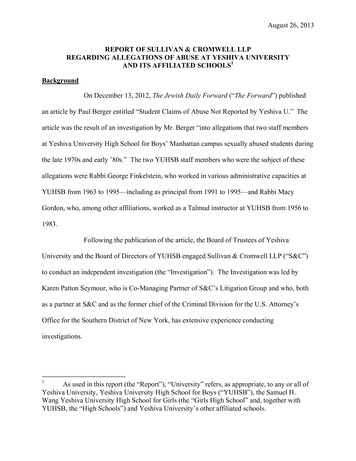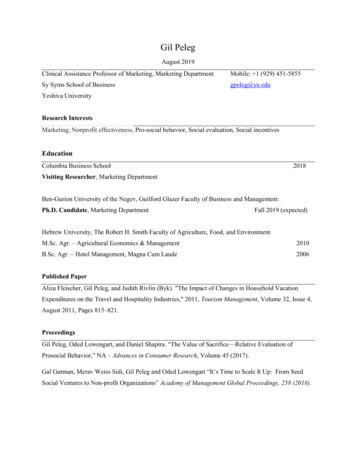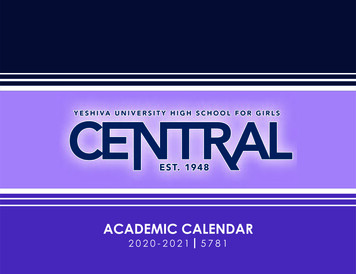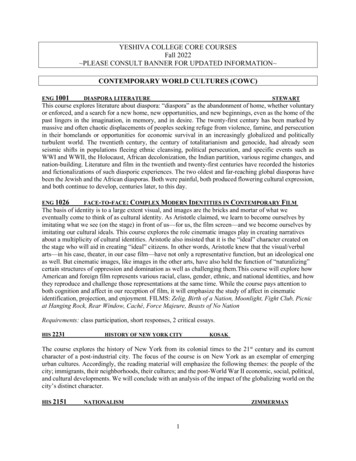
Transcription
YESHIVA COLLEGE CORE COURSESFall 2022 PLEASE CONSULT BANNER FOR UPDATED INFORMATION CONTEMPORARY WORLD CULTURES (COWC)ENG 1001DIASPORA LITERATUREENG 1026FACE-TO-FACE: COMPLEX MODERN IDENTITIES IN CONTEMPORARY FILMSTEWARTThis course explores literature about diaspora: “diaspora” as the abandonment of home, whether voluntaryor enforced, and a search for a new home, new opportunities, and new beginnings, even as the home of thepast lingers in the imagination, in memory, and in desire. The twenty-first century has been marked bymassive and often chaotic displacements of peoples seeking refuge from violence, famine, and persecutionin their homelands or opportunities for economic survival in an increasingly globalized and politicallyturbulent world. The twentieth century, the century of totalitarianism and genocide, had already seenseismic shifts in populations fleeing ethnic cleansing, political persecution, and specific events such asWWI and WWII, the Holocaust, African decolonization, the Indian partition, various regime changes, andnation-building. Literature and film in the twentieth and twenty-first centuries have recorded the historiesand fictionalizations of such diasporic experiences. The two oldest and far-reaching global diasporas havebeen the Jewish and the African diasporas. Both were painful, both produced flowering cultural expression,and both continue to develop, centuries later, to this day.The basis of identity is to a large extent visual, and images are the bricks and mortar of what weeventually come to think of as cultural identity. As Aristotle claimed, we learn to become ourselves byimitating what we see (on the stage) in front of us—for us, the film screen—and we become ourselves byimitating our cultural ideals. This course explores the role cinematic images play in creating narrativesabout a multiplicity of cultural identities. Aristotle also insisted that it is the “ideal” character created onthe stage who will aid in creating “ideal” citizens. In other words, Aristotle knew that the visual/verbalarts—in his case, theater, in our case film—have not only a representative function, but an ideological oneas well. But cinematic images, like images in the other arts, have also held the function of “naturalizing”certain structures of oppression and domination as well as challenging them.This course will explore howAmerican and foreign film represents various racial, class, gender, ethnic, and national identities, and howthey reproduce and challenge those representations at the same time. While the course pays attention toboth cognition and affect in our reception of film, it will emphasize the study of affect in cinematicidentification, projection, and enjoyment. FILMS: Zelig, Birth of a Nation, Moonlight, Fight Club, Picnicat Hanging Rock, Rear Window, Caché, Force Majeure, Beasts of No NationRequirements: class participation, short responses, 2 critical essays.HIS 2231HISTORY OF NEW YORK CITYKOSAKThe course explores the history of New York from its colonial times to the 21st century and its currentcharacter of a post-industrial city. The focus of the course is on New York as an exemplar of emergingurban cultures. Accordingly, the reading material will emphasize the following themes: the people of thecity; immigrants, their neighborhoods, their cultures; and the post-World War II economic, social, political,and cultural developments. We will conclude with an analysis of the impact of the globalizing world on thecity’s distinct character.HIS 2151NATIONALISMZIMMERMAN1
MUS 1013HMUSIC AND THE WORLD WARSHONORS FTOC ONLY (611)BELIAVSKYMUS 1014SCHAPIROBroadly, this course attempts to show how 20th century deviations from traditional Western musicalparameters defined European and American art music not only as falling within the canonic continuum ofdevelopment and innovation, but simultaneously as an eclectic collection transformed and informed by nonWestern aesthetic techniques, philosophy, and practice, and considerably influenced by the two WorldWars. Specifically, by analyzing the influence of dictators such as Hitler and Stalin on musical expressionwithin their countries, this course examines the relationship between oppression and creativity throughnarratives of the imprisonments and emigrations that resulted from the wars.AMERICAN MUSICAL CULTURESIs there an America? Can this question be answered, or can we at least find clues, by learning about andunderstanding its music? American Musical Cultures will examine the relationship between a culture, or inmany cases a subculture, and its music. What makes something American? What makes music American?Does understanding the music of a society provide insights into its culture? Through readings, video,assigned listening, and class discussion, we will explore American diversity. We will find that musicdemonstrates both inclusion and individuality, stressing teamwork, but never at the expense of self-identity.The “American diversity” we will explore covers ethnicity and religion. But American diversity is alsoregional, generational, and inevitably viewed in values and modes of thought and behavior. Similarly, theword culture can be used to explain the attitudes and activities of people not only belonging to specificregions and ethnicities, but to eras. Such a breakdown is discernible where a community produces a pluralityof musical approaches. The course will enable students: to understand the diverse nature of Americanculture(s); to analyze the meaning and components of culture; to create and defend arguments synthesizingelements across cultural groups.In order to have any ability to approach the question, What is American music? or What is Americanculture?, it will be necessary to consider cultures and music from beyond the Americas. Thus, in thebroadest picture, we consider what aspects of music are universal. When this is established, we can thinkabout what makes American music American. From there we consider the categories that reveal diversity:generation, race, region, and ultimately the spectrum of thought process that makes us human.POL 2299DEMOCRACY AND DEVELOPMENTPANZARELLIPOL 2298POPULISMPANZARELLI2
CULTURES OVER TIME (CUOT)ART 1635HEVOLUTION OF THE SKYSCRAPERGLASSMANWe shall examine the conception, development and construction of the skyscraper. Since the tall officebuilding flourished in Chicago as nowhere else during the last century, we shall begin with the roots of thetall office building in that city. The course will include selections from the theoretical literature on the natureof the tall building. New York City, with its unparalleled concentration of skyscrapers in lower and mid-townManhattan, will serve as our learning laboratory. Presentations by practitioners and class members areincluded. Starting with the history of and theories about this building type and its early stages in thenineteenth century, we shall examine the following topics: The early history of the tall office building:embracing the machine age; The impact of zoning ordinances on urban form; The role of the real estatedeveloper; The architect and the design process; Systems synthesis: engineering and construction; Makingspace comfortable: the role of the interior architect.ENG 1009HFRANCE AND ITS OTHERSMESCHWhile the notion of a cultural “melting pot” is central to American society, French society hasbeen structured around a distinctly French notion of universalism: the idea that there are coreuniversal values that must supersede those of any minority subculture. Thus, although Americansregularly embrace multiple identifications--as African-Americans, or Jewish Americans, forexample--in France that double alliance is largely experienced as a tension.This class traces the roots of that tension by examining ways that otherness has inspired andtroubled the French imagination through literary, historical and philosophical readings by majorFrench writers from the 1500s to the present day. From Montaigne’s cannibals to the noblesavages of Enlightenment texts, from Zola’s “J’accuse!” to the story of Babar, from the femaleother to the other as Jew to the other as Jewish female, we will explore the myriad ways throughwhich France’s imagined others serve as manifestations of a cultural fascination with and anxietyabout difference in its many forms. As we analyze the various intellectual conflicts that havearisen from the quest to understand what is deemed different, foreign, exotic or strange, we willalso trace a struggle to define and circumscribe notions of French identity, selfhood andauthority. Finally, at the semester’s end, we will use what we have synthesized from thesethinkers to consider contemporary debates in French society about the place of religious andethnic difference in the public sphere.ENG 1023HAUTHORSHIP: FROM PLATO TO WIKIPEDIAFITZGERALDIn Western culture, the hallmark of a true author is that he or she produces “original” writing andideas, and because these words and ideas are seen as originating from him or her, he or she is saidto be the “owner” of this work. This wasn’t always the case.In the long history of writing, during the vast majority of which only a very small percentage ofpeople were able to read and an even smaller percentage could write, conceptions of authorshipchanged dramatically. In classical and medieval times, far from being seen as originators, authors(some of whom, as part of an oral tradition, did not write) were seen as merely the vessels throughwhich the gods or God spoke. Even at those times when originality was prized, so too other forms ofwriting were valued; in the Renaissance and eighteenth century, for example, imitation was arespected form of writing, both a way of learning to write and a form of authorship in which theauthor aimed to reflect nature.3
However, in the eighteenth century, an idea of the author emerged that is more familiar to us now.Literacy began to rise beyond the privileged classes, which meant that money could be made byselling works to a growing reading public. But publishers wanted to ensure that their profits wouldnot be depleted by copies made by “pirates,” so they argued in several crucial legal cases(predecessors of copyright laws today) that authors were the “owners” of their work and thatpublishers bought the right to copy it. In addition, in the century that followed, writers of thisperiod—many of whom were known as “Romantics”—were increasingly interested in thepossibility that their work originated not from divine sources or even as a reflection of the worldaround them but from their own minds and memories, as expressions of their unique andindividual selves. Several scholars have argued that the economic incentives of the publisherscombined with these romantic notions of authorship to produce modern European and Americanideas of authorial originality—of words and ideas originating in unique ways from individuals, asexpressions of their “own” particular feelings, thoughts, and perspectives.Much has happened since the late eighteenth and early nineteenth centuries to call into questionthis individualistic and “proprietary” idea of authorship. In the late twentieth century, scholarsinterested in authorship began to demonstrate that the romantic myth of the solitary andproprietary author is just that, a myth. For one thing, authors (and writers) do not write inisolation, even when they write alone. They learn their words and phrases and ideas from others;writing, in other words, is social, part of a series of networks that link all texts to other texts. We cansee traces of these networks in the ways writers indicate, by citing their sources, how they draw onother writers’ ideas and language—a process that, ironically, given the emphasis on originality, can,in academic contexts, help to “authorize” them as experts on their topics. Internet hyperlinks makethis network more visible than ever by literally connecting online texts to each other. Moreover,much of the writing that’s conducted in the workplace is produced collaboratively, sometimes bymany people. Again, the Internet helps to make the collaborative nature of much writing apparent,in, for instance, the multiple, collaborative, usually anonymous authorship of Wikipedia.HIS 2601/POL 2495HISTORY OF THE LAWBURGESSThis course examines the development of the law from an historical and sociological perspective.Through a combination of lecture and discussion of assigned readings, students will be introduced to thefoundational documents of the law, their historical context, and their relevance to the evolution of humansociety. Students will be expected to recognize and comprehend major themes of private and public law,the relationship of subject and sovereign, rights of the individual, law and statecraft, and the philosophyof law.Requirements: class participation & attendance; midterm; final paper.HIS 2710COFFEE AND THE CREATION OF MODERNITYLEVINCoffee, one of the most valuable commodities traded on world markets, is ubiquitous in contemporaryAmerican culture - so much so that it’s difficult to imagine that there was a time before coffee. But therewas. Coffee wasn’t introduced into the Ottoman Empire until the end of the fifteenth century and intoEurope until the seventeenth century. The world at the end of the eighteenth century looked very differentthan it had at the beginning of the sixteenth, and coffee had much to do with it. The early modern worldsaw the birth of many aspects of culture and society that we consider “modern,” including “nightlife” inall its varieties; a bourgeois “middle class;” “consumerism,”a “public sphere” and “globalization.”Together we’ll analyze the central role coffee as beverage, drug, commodity and artifact of daily lifeplayed in their creation and in the creation of what we’ve come to know as “modernity.” Together we will4
examine the introduction and reception of coffee in the late medieval Ottoman world and in seventeenthand eighteenth-century Europe. Using journalistic, literary, and visual sources we will explore howmultiple societies responded to the introduction of coffee - a novel, foreign and exotic drink - as well ashow the eventual European thirst for coffee impelled the development of a system of colonialism or worldtrade. Drawing on approaches from disciplines including history, sociology and anthropology, we willtrace how coffee, an everyday object, transformed various cultures into which it was introduced. We’llalso consider how the act of drinking coffee took on divergent political and cultural symbolism indisparate contexts, including the Ottoman world, European nations, and colonial societies. We’ll devotemuch of our time in class to analysis and close reading of primary sources, including texts of multiplegenres as well as images. Of course, coffee drinkers and non-coffee drinkers are welcome.HIS 2909MEDIA REVOLUTIONS: FROM SCROLL TO SCREENPHI 1011INTRODUCTION TO PHILOSOPHYFREEDMANThis course will survey the history of media from the ancient world to the present. Taking"media" in the broadest sense to encompass the full range of communications technologies, wewill begin with the papyri scrolls of ancient Greece and move from there through the manuscriptcodex of the Middle Ages, the printed book of the age of Gutenberg, newspapers in the 18th and19th centuries, radio and film in the 20th century, and the internet and social media of our owndigital age. Several recurrent questions will frame our survey of media landscapes: How, to whatends, and in what institutional settings are particular media used? How do they affect modes ofthinking? And what are the relations of different media to the various historical forms ofreligious, political, and economic power?Requirements will include a midterm, final, and a paper of 4-6 pages.JOHNSONPeople study philosophy because they want to know the answers to certain important questionssuch as those mentioned below. Philosophy usually fails in its attempts to answer them, butpeople keep returning to it because there is no other path to wisdom about such matters. (There issomething to be said for knowing what doesn’t work; and the study of philosophy greatlyenhances the critical powers of the mind.) We will be concerned with such questions as thefollowing: (i) Does God exist?, (ii) Is there such a thing as human free will, and, if so, what is itsnature?, (iii) Is human free will compatible with perfect Divine foreknowledge?, (iv) Is humanfree will compatible with determinism?, (v) Are there moral truths, and, if so, how do we knowwhat they are?, (vi) What is the nature of truth?, (vii) What is the nature of infinity?, (viii) Whatis the nature of probability?, (ix) What is the nature of knowledge?, (x) What is the case for, andagainst, skepticism?, (xi) Do the things around you exist? (Answer: No.), (xii) Are we physicalobjects?5
EXPERIMENTAL AND QUANTITATIVE METHODS (EXQM)COM 1300INTRODUCTION TO COMPUTER SCIENCEDIAMENTECO 1421ECONOMETRICSSTAFFPHI 1100HLOGICJOHNSONIntroduction to formal logic.PSY 1021PSY 2100CSTATISTICS FOR PSYCHOLOGYMALKAEXPERIMENTAL PSYCHOLOGYGALANTUCCITraining in the problems, methods, and evaluation of experimental research in psychology. Studentsperform individual experiments, prepare reports of results, and are introduced to the literature ofexperimental psychology.STA 1021INTRODUCTION TO STATISTICSGRIVOYANNISSources and types of quantitative data; descriptive statistics: graphic displays and frequencydistributions, measures of central tendency and variation; samples and populations; shapes ofdistributions (bimodal, skewness, kurtosis); probability and statistical decision making; samplingdistributions (binomial, F, normal, Students,T, U, chi-square); inferential statistics:approximating percentages, estimating procedures, testing hypotheses for differences orrelationships (including regression and trend analyses); tests to check model assumptions;correlation versus causation; lying with statistics.6
HUMAN BEHAVIOR AND SOCIAL INSTITUTION (HBSI)ECO 1010PRINCIPLES OF ECONOMICSSHAOECO 1010PRINCIPLES OF ECONOMICSBLOISEPOL 1101INTRODUCTION TO AMERICAN POLITICSINCANTALUPOPOL 2135VOTING AND ELECTIONSINCANTALUPOOverview of the formal institutions and functions of the national government (Congress,presidency, courts); their interactions with state and local governments, and with informalinstitutions of political power (political parties, interest groups, social movements, publicopinion, media).POL 2145AMERICAN CONSTITUTIONAL LAWPOL 2330TERRORISMKAMINETZKYStudents will gain a deeper understanding of and appreciation for the Supreme Court’s role increating, defining, interpreting, expanding and limiting civil rights in the United States byreading and analyzing Court decisions and the U.S. Constitution. Through an analysis ofmajority opinions, concurrences and dissents, we will identify, explore and discuss the variousmethods of constitutional interpretation -- such as Textualism, Original Meaning, JudicialPrecedent, Pragmatism, Moral Reasoning, among others – and question the utility, fairness,limitations and risks of each approach. Topics will include right to privacy, free speech, racialand gender discrimination, freedom of religion, right to bear arms, freedom of the press andrights of the criminally accused.ZAITSEVAThe course introduces students to the study of modern terrorism. It explores terrorism’s definitions,history and typology with a particular focus on the internationalization of terrorism in the last couple ofdecades. The course further aims to understand terrorists’ goals, tactics, sources of financing, andrecruitment. The second half of the course focuses on counter-terrorism, including evaluation ofterrorism’s success and the prospects of effectively combating it in the future. The objectives of courseinclude: 1) exposing students to the complexities of modern terrorism; 2) refining students’ oral andwritten skills through a series of group-based terrorism case studies; 3) challenging students to thinkcritically about solutions and approaches to terrorism.7
INTERPRETING THE CREATIVE (INTC)ENG 1001BOOKS ON BOOKS/FILMS ON FILMSGEYHWhat do literature and film tell us about themselves and each other? What are the elementalforms and structures of literary and filmic narrative? What approaches might one use for theanalysis of literature and film? How is reading a novel or short story different from “reading” afilm? By addressing these questions, this course will help students to develop a deeperunderstanding of how narrative literature and film work and how they’re related (or aren’t).The course will begin by considering the relationship between truth and fiction, and some ideasabout what “art” is and does. We’ll examine the roles of readers, film viewers, authors, directors,and critics. We’ll explore the forms and structures of literary and cinematic storytelling, and howthese elements come together to produce meaning. Finally, we’ll briefly survey variousapproaches used by scholars and critics to analyze literature and film.Course texts will include Zusak’s The Book Thief and Calvino’s If on a Winter’s Night a Traveler.Films will include The Wizard of Oz, Sherlock Jr., Stranger than Fiction, Singin’ in the Rain, andCinema Paradiso. Critical texts will include Plato, Books VII and X of The Republic; Wilde, “TheDecay of Lying”; Wellek & Warren, “The Nature and Modes of Narrative Fiction”; Lynn, Textsand Contexts; Rushdie, The Wizard of Oz; and Spadoni, A Pocket Guide to Analyzing Film.ENG 1013WORDS TO LIVE BY: LITERATURE, MORALITY AND ENTERTAINMENT LAVINSKYThe didactic and moral content of English literature often seems in conflict with modern notions of readingas a form of entertainment or imaginative escape. What happens, for instance, if we derive pleasure orenjoyment from a text meant instead to reform our behavior or provide examples of how to act? And whatdoes it mean if we discover moral or ethical models in literature intended merely to entertain? Doesliterature have ennobling effects? By the same logic, can artifice inspire immorality, or distract us fromwhat truly matters? And what becomes of the reader who resists or is already estranged, because of religiousor cultural identity, from a text’s prescriptive intent? We will approach these questions from differentcultural and aesthetic vantage points, all variously concerned with how certain literary and artistic formsinscribe their audiences in the stories they tell, scripting a specific moral response in the process. Ourinvestigation will ground itself in readings from classical antiquity before considering the interrelation ofartistic form and moral meaning in specific contexts. We will track anxieties about the spiritualconsequences of imaginative diversion and departure; reconsider the relationship between religious art andsecular forms of entertainment, and the utility of the sacred/secular distinction more generally; explore thedifferent ways in which visual, textual, and performative mediums exert a hold on our minds (and bodies);and assess how these concerns are implicated in contemporary debates about the problematics of readingand moral exemplification. Many of our readings will be drawn from early English poetry, prose, anddrama, though no previous exposure to this period or its literature is assumed, and a wide range of criticaland theoretical texts will help students situate unfamiliar material.ENG 1036TRAVEL WRITINGLAVINSKYIn this class, we will explore an assortment of literary and historical texts all broadly defined as“travel writing.” Our investigation begins in classical antiquity, with material focused on thewestward migration of refugees following the Trojan War. Turning to later periods, it then8
examines how crusades, pilgrimages, mass expulsions, and explorations to the far reaches of theknown world reflected—and shaped—medieval notions of cultural difference; key here is theaccount of Italian merchant adventurer Marco Polo. Next, we consider the age of discovery, andthe role maps and other geographic conventions played in early modern representations of theAtlantic, perhaps most notably in Shakespeare and his contemporaries. After considering theseand other sources (e.g., selections from Ibn Battuta, Jonathan Swift, Mark Twain, Freya Stark, andJamaica Kincaid), the semester concludes with travel narratives that frame the experience of therefugee, the migrant, and the asylum seeker. Implicit in all these cases is the idea that travel writingis not just an aesthetic or stylistic choice but also an attempt to grapple with the complexities ofhistorical experience. Hence our focus on its changing contexts; major topics include race, slavery,colonialism, religious difference, emigration, empire, commerce, tourism, and the exotic. Inaddition to critical essays and presentations, students will have the opportunity to write their owntravel narratives.ENG 1088READING AND WRITING POETRYENG ?THE JEW IN THE WESTERN LITERARY IMAGINATIONMUS 4930SECT 241MUSIC OF THE BEATLESDORNMW 4:30 – 5:45 PMNES 1020HSECTION 621ANCIENT EGYPTIAN LITERATUREKOLLERF 10:00 AM – 12:30 PMTRIMBOLITRAPEDOFrom medieval blood libels to Ulysses’s Leopold Bloom, the figure of the Jew has loomed large in theWestern literary imagination. This course will examine how authors through the ages have representedJewishness in poetry and prose for their predominantly Christian readers. How are Jews positioned inrelation to law, commerce, community, morality, sexuality, wisdom, and faith in the fictional worlds theyinhabit? What technical or thematic purpose do Jewish characters serve in the construction of text as awhole? Through deep engagemenft with a variety of texts, we’ll consider to what extent these works reflect,reinforce, challenge, and/or change the existing archetypes and assumptions about Jews in their respectivehistorical and cultural moments, and how these characterizations reverberate in the social history of antisemitism (and philosemitism). We’ll also briefly consider the literary afterlives of these characters in thehands of Jewish writers, such as Will Eisner’s graphic novel Faygin and Philip Roth’s OperationShylock. Taught under the auspices of both the English department and the Straus Center for Torah andWestern Thought, this course will feature occasional guest lectures by affiliated humanities faculty.A survey of 2000 years of literature from ancient Egypt – stories, poems, instructions, magical spells,royal inscriptions – and their historical and social contexts. Including, if possible, a class trip to theBrooklyn and/or the Metropolitan Museum.THE NATURAL WORLD (NAWO)BIO 1014PRINCIPLES LECTURESCHE 1045RGENERAL CHEMISTRY I LECPHY 1031RINTRO PHYSICS LECTUREPHY 1051RGENERAL PHYSICS IMAITRAVISWANATHANASHERIECWILICH9
SCI 1012SCIENTIFIC LITERACY FOR RESPONSIBLE CITIZENSHIPCAMARAScience is the principle means by which we come to understand our environment, the planet andthe universe. Science also has the ability not only to affect our day-to-day lives, but also toshape our future as individuals and as societies. The responsible citizen must be able to educatehimself/herself about scientific matters that have the potential to impact civilization. This courseaims to (1) expose you to current issues in modern science that have potential to impact daily lifeand (2) to give you the skills necessary to educate yourself and engage in discourse aboutscientific developments in the modern age. We will explore a variety of scientific topics throughvarious modern media including primary scientific literature, popular science columns,documentary films, podcasts, blogs and social media. We will learn how to critically analyzeinformation in each of these media and how to analyze issues related to the application ofscientific breakthroughs to our daily life. Finally, we learn about the government agencies thatadjudicate and regulate how science interacts with society in our daily lives.10
1 YESHIVA COLLEGE CORE COURSES . Fall 2022 PLEASE CONSULT BANNER FOR UPDATED INFORMATION CONTEMPORARY WORLD CULTURES (COWC) ENG 1001 DIASPORA LITERATURE STEWART. This course explores literature about diaspora: "diaspora" as the abandonment of home, whether voluntary
